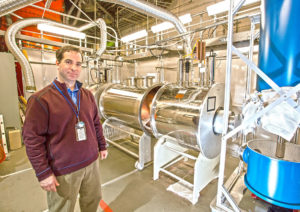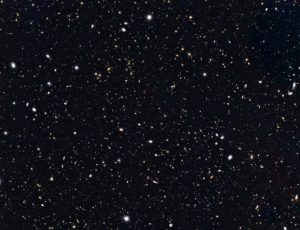The PTOLEMY project, based at Princeton University, explores the origins of the universe less than a second after the Big Bang. The key? Tiny messengers with information about the early universe, known as neutrinos, that have passed freely through the detritus of the universe since the very beginning.

Chris Tully (Photo by Elle Starkman, PPPL Communications)
To look deep into space is to look back in time.
Yet even our most powerful telescopes do not let us peer all the way back to the genesis of the universe 13.8 billion years ago. Roughly the first 380,000 years of our cosmic existence is obscured. Only after crossing this threshold was the universe sufficiently cool that light could travel freely through space and eventually reach our telescopes.
Dr. Christopher Tully at Princeton University, however, has a plan to bring those pivotal first few moments into view. If successful, we might finally behold the first few instants after the Big Bang.
Tully leads an experiment, PTOLEMY, whose goal is to capture signals from neutrinos, particles spewed out by the newborn universe. Unlike massless photons, neutrinos have tiny mass but can pass right through the gas, dust, and other matter strewn throughout the cosmos. Every second, in fact, trillions of ghostly neutrinos zip right through every human on earth.
As aloof as neutrinos are, they do — in rare instances — interact with atoms, adding a fillip of energy. Over recent decades, scientists have constructed neutrino detection labs in remote locales, such as underground tanks of ultra-pure water and the pristine ices at the South Pole, to reduce contamination from everyday sources. These experiments catch neutrinos made by our sun, as well as from the explosions of distant stars. Building on these successes, Tully wondered if scientists might somehow tune into the elusive, relic neutrinos spawned by the Big Bang.
“This was considered an impossible task even though, theoretically, there should be more ‘cold,’ low-energy neutrinos from the Big Bang than any other sources,” Tully says. “So I started to put together what I thought was the most compelling set of technologies to go after this neutrino signal.”
On the Hunt for Telltale Big Bang Signals
Those technologies have come together in the PTOLEMY experiment (short for “Princeton Tritium Observatory for Light, Early-Universe, Massive-Neutrino Yield”), which began operating in late 2016 to test Tully’s conceptual framework.
At the heart of the PTOLEMY detector are atoms of tritium, a variant of hydrogen. Typical neutrinos add millions of times more energy to the natural radioactive decay process in tritium compared with relic neutrinos that have traveled across the expanding universe for nearly 14 eons. PTOLEMY aims to measure the minuscule bit of extra energy that only relic neutrinos could plausibly impart.
“It’s a very distinctive signal,” says Tully. “There is almost no other way the universe could generate it.”
These potential detections require, among other innovations, extremely sensitive temperature sensors. Tully hired a post-doctoral student to help overcome the challenge of loading the tritium onto an atom-thick layer of carbon, called graphene. Doing so ensures as clean a signal as possible from any perturbing relic neutrinos.

Source: NASA
A Whole New Way of Studying Reality
Should PTOLEMY successfully demonstrate a way to sniff out ancient Big Bang neutrinos, Tully will request major federal funding to build a full-scale experiment that would empower scientists to investigate the universe when it was a mere second old. Testing fundamental predictions of cosmological theory could offer unprecedented insight into ultimate reality.
“This relic neutrino search into how universe works seems to me to be the biggest contribution I could possibly make to our knowledge of physics,” Tully adds. “I realize it’s not a quick or easy path, but I’m optimistic we can make a big discovery.”